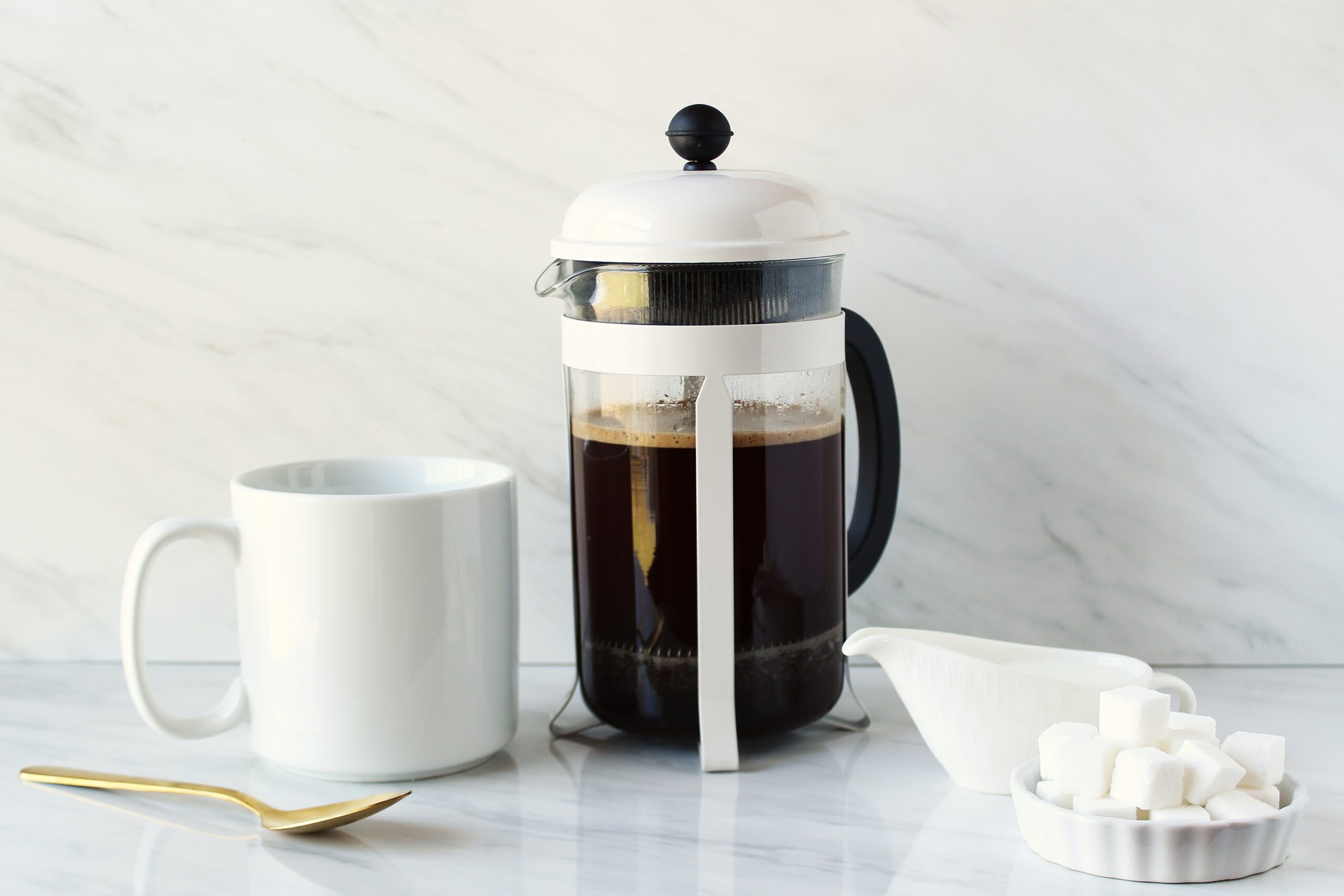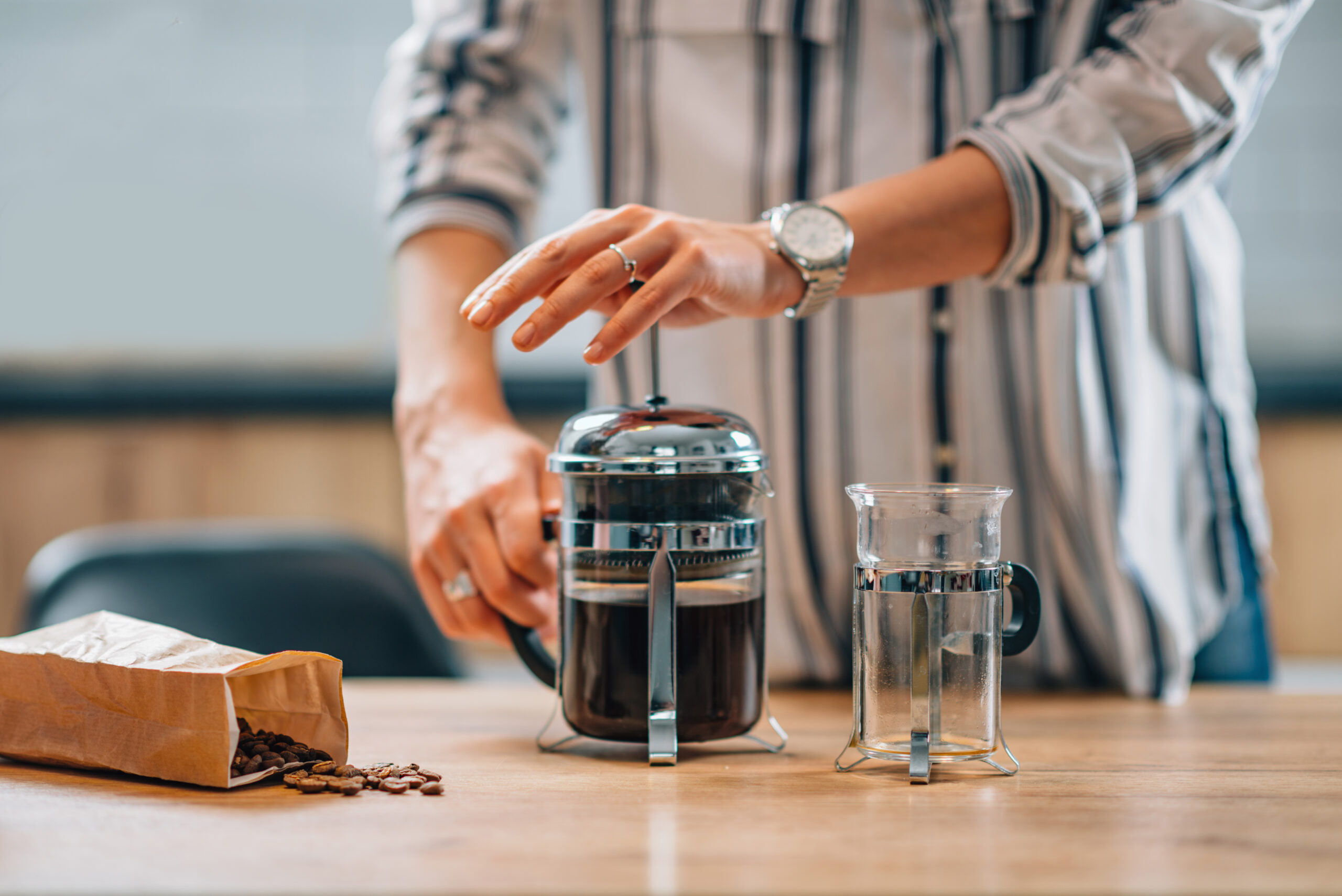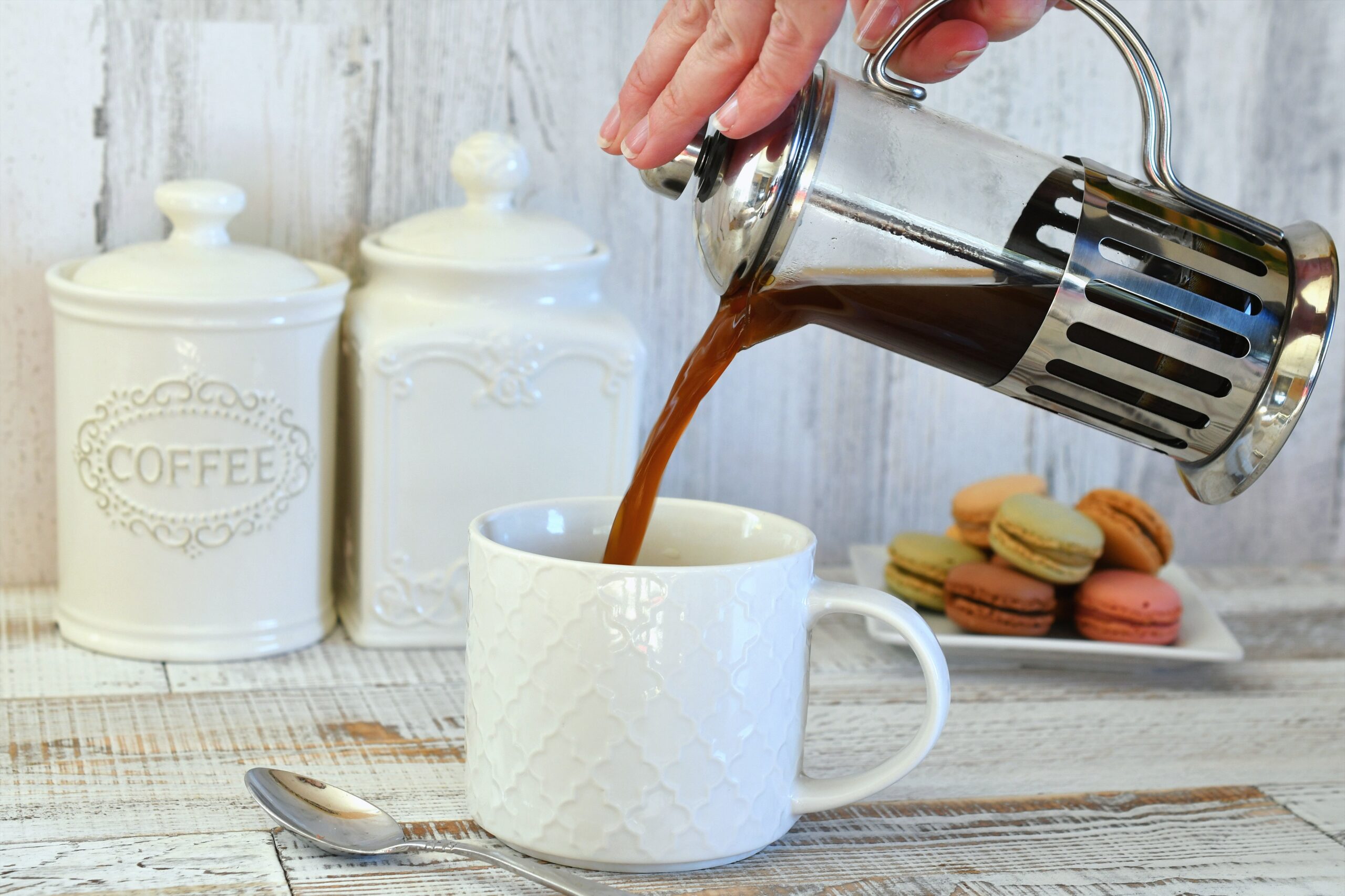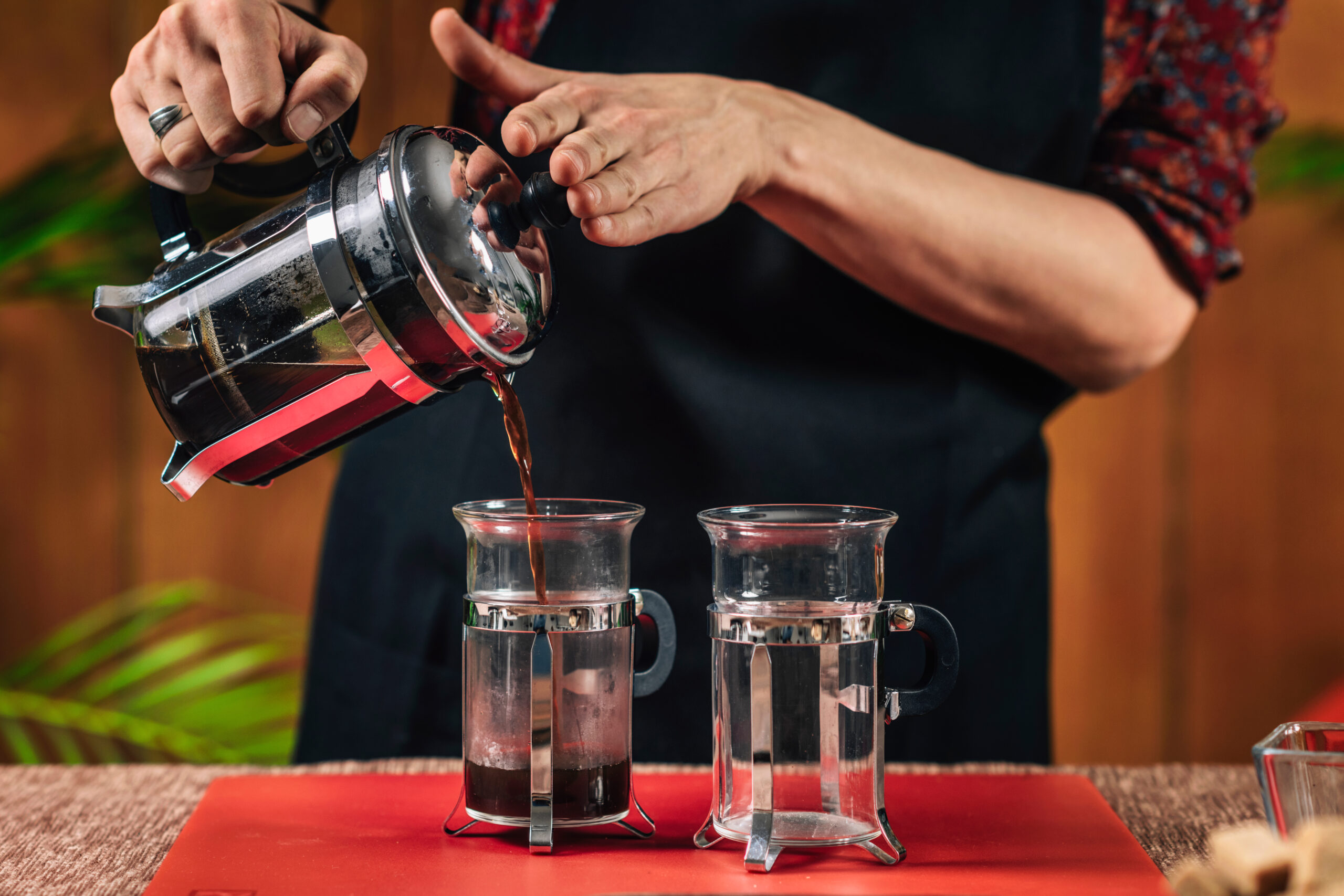If you’re looking to buy a French press coffee maker but aren’t sure what to look for, you’re in the right place! French press is my favorite brewing method, and I use it almost every single morning to make my coffee.
Over the years, I’ve used a bunch of different French presses, from ones that are utilitarian and could survive an apocalypse to those that are fragile as anything but look nice on your counter. What most people don’t know is that the type of French press you buy will actually affect the flavor of your coffee immensely. In this guide, I’ll discuss why that is and help you decide which French press is the best one for you. Let’s start by discussing why your French press selection matters.

Exactly How Your French Press Changes Your Coffee Experience
First, it’s worth talking about why and how the specific French press you buy will make a difference in your coffee. There are two main parts of the extraction process that can be altered based on which French press you have. I’ll discuss these below and nerd out a little bit about how these work.
Primary Extraction
The primary extraction happens in the French press when you’re actually brewing your coffee. Basically, you mix hot water with your coffee grounds in the brewing chamber, and the interaction between the two starts pulling compounds out of the grounds. The compounds include:
- Carbohydrates and sugars
- Coffee oils, like cafestol and kahweol
- Caffeine
- Acids — like chlorogenic acid lactones, which contribute to bitterness
- Phenylindanes
- Melanoidins
Since the chemical interactions that cause the extraction of these compounds speeds up at higher temperatures, how hot your water is matters a great deal. Not only that, but the strike temperature of the water — how hot it is when you first pour it in — as well as the temperature over time, make big differences in your cup.
There are a few features you can look for in a French press to help regulate the temperature over the brewing time in your brewing chamber, but for now, just know that maintaining a high temperature — ideally between 190 and 210 degrees (F) over the ~4 minutes of brew time is crucial for delicious, full-flavor coffee that isn’t under-extracted.
Secondary Extraction
French press is unfiltered coffee, even though you use the reusable metal mesh filters to press the majority of the grounds out of your brewed coffee. When you press and pour, you’ll still see some grounds in your coffee, often referred to as the “fines,” or the small pieces of grounds that slip through the metal mesh. This is unavoidable unless you use a paper filter, and it’s what leaves that “coffee mud” in the bottom of your coffee.

Secondary extraction occurs in all French press coffee after you press and pour that isn’t passed through a paper filter. Basically, the hot water will continue pulling compounds out of those fines, which leads to a secondary extraction. If you don’t drink your French press coffee shortly after you press and pour it, the extraction from those fines will continue.
This isn’t necessarily a problem, but it can lead to over-extracted coffee, which can taste overly bitter and acidic. The reason for this is that the compounds that contribute to bitterness and acidity take longer to pull from your grounds. During the primary extraction, you get only some of these compounds in your cup. The secondary extraction process can pull too many of these compounds and leave you with an imbalanced cup of coffee.
Okay…nerd-out complete. And now that you know how and why the flavor of your coffee can change based on how you brew it in a French press, we can get to the real crux of this article…
What to Look for in a French Press Coffee Maker
There are a few features I recommend you look for in a French press before you buy. Some of these will influence the primary and secondary extraction processes mentioned above, and others are just quality-of-life features that I think are worth considering.
French Press Material: Glass French Press vs Metal French Press vs Stoneware French Press
The first thing I recommend you look at is the material the French press is made of. The material makes a few differences in the quality of your brew and the longevity of your brewing equipment.
Since the temperature inside your French press throughout the several-minute-long brewing timeline makes a difference in your final product, you ideally want a material that can resist heat transfer to the exterior of your brewer. The faster the walls of your French press leach heat to the room, the more your brewing coffee inside will cool, and the slower your extraction will be. As discussed above, this will affect the flavor and balance in your cup.
Single-wall glass French presses are the worst for this purpose. Although glass is a good insulator, the thin single wall means heat will be lost more quickly to the room than an insulated French press.
If you run a temperature probe inside a glass French press and check the temperature over time — and yes, I actually have done this — you’ll see a steady decline in the temperature at a faster rate than you would with other materials that more commonly use two layers. A thin, single layer of glass is about the worst you can do in terms of heat retention in a French press.

A double-wall glass French press will be the best option for heat retention and proper brewing temperature.Double-wall glass provides an additional layer of air between the glass pieces that reduces heat transfer outside of your brewer. I would urge you not to use a single-wall glass French press, and although a double-wall glass one isn’t my top pick because of low durability, it is the best option for temperature purposes. They’re just less common.
A single-wall stoneware French press — like the Le Creuset Stoneware French Press — of equal thickness will always be better than a single-wall glass French press, as the ceramic material is a better thermal insulator. Stone French presses are less common and more expensive, but they’re also gorgeous and can serve as a piece of decor as much as they can be an integral part of your morning routine.
One thing to note is that stone French presses take a bit longer to “pre-heat” because of the slow rate of heat transfer. This isn’t a huge deal, but it’s something you should be aware of if you’re looking to make delicious and consistent coffee.
A single-wall metal French press is the worst option. Although it keeps costs down, it provides the least insulation compared to equivalent thicknesses of glass and stone. However, a double-wall metal French press with a vacuum seal between the layers is the ideal option, in my opinion.
These brewers can easily maintain your brewing coffee within the ideal temperature range, and they often lose less than a degree or two throughout the entire brewing process. Plus, they’re the most durable.
French Press Wall Thickness: Single-Wall vs Double-Wall French Press
The thickness of your French press matters a great deal, as you probably gathered from the previous section. It’s hard to talk about French press material without talking about single vs. double walls.
Any material at a greater thickness will provide more insulation and help keep your brewing coffee at the proper temperature. Basically, having a double wall will reduce heat transfer to the room around your French press, which helps maintain a good brewing temperature inside the coffee maker.

Remember, the strike temperature — the temperature of your water when you first pour it over your grounds — is a critical piece of the puzzle to get right, but the water temperature throughout the brewing process is also crucial. Keeping your coffee between 190 and 210 degrees — and ideally between 195 and 205 degrees — is best and will lead to a nicely balanced cup of coffee that’s not too acidic, bitter, or sour.
Below are two quick notes on how to assess why your French press coffee doesn’t taste right:
- If you’re getting sour or salty flavors in your cup, then your coffee is under-extracted. This is either a result of grinding too coarsely or losing too much heat from your French press. A thicker material or a double-wall French press will probably suit you better.
- If you’re getting overly bitter or acidic French press coffee, it’s probably over-extracted. That either means you’re grinding too finely, or the metal mesh filters in your French press are letting too many fines pass through. More on this a bit later. Thankfully, though, brewing temperature usually isn’t the issue in this case.
Filter Size & Options
The permanent “filters” in your French press push most of the grounds out of your coffee to halt the extraction process and prevent those bitter and overly acidic compounds from continuing to accrue in your brewed coffee. Remember, the more fines you pull out of your coffee, the less ongoing extraction you’ll have after you pour your coffee, and the less coffee mud you’ll have at the bottom of your cup.
Most French press coffee makers include at least a single metal mesh filter that attaches to the bottom of the plunger. The finer the mesh is, the more it will filter out and the less risk you’ll run of over-extracted coffee, especially if you let your cup sit for a while after brewing.
A lot of French presses don’t actually tell you how fine the mesh is, so you kind of either have to trust French press reviews or do some product testing for yourself, which is expensive and time-consuming. You can check out my article on the best French presses for guidance on how to choose one that has a good metal mesh filter.
You’ll also see a few different options for filtration on some French presses. Some come with an insert to place a small, round paper filter made just for French press coffee. These will take out some of the coffee oils that deliver the rich, full mouthfeel of French press coffee, but they will also remove a lot of the fines, which can help halt extraction when you pour.
You also have less common French press basket filters, which you’ll see on the French presses from ESPRO. The Espro P7, for example, uses a filter basket that has two layers of super-fine metal mesh, as well as a gasket around the edge of the plunger to prevent fines from finding their way out. This helps cut down on the risk of over-extraction.
Handle
The handle on your French press usually doesn’t matter all that much, but when it’s bad, it’s really bad. Generally speaking, you shouldn’t have to worry too much about the handle unless it’s really small and leaves your knuckles close to the body of the French press when you grab it.
I don’t know why anyone would make a French press like this, but I’ve used a glass one before that would burn my knuckles just about every time I used it unless I prepared and picked it up carefully to avoid making contact with the outer wall.
You can really just take a quick look at a picture of a French press you’re considering to see if the space for your hand around the handle is too small. You also don’t usually need to worry about this on a double-wall metal French press, as the outer wall of the stainless steel shouldn’t get too hot to touch — a sign of good insulative properties!
Overall Size of the French Press
The capacity of your French press is something you should consider, especially if you make coffee for multiple people in your home every morning or want to be able to make coffee for company. I have two French presses: one large one for multiple cups if I’m brewing for friends or family as well, and one smaller one for making coffee just for my wife and me.

You might think that just buying a large French press means you can use it in both instances — for big and small batches — but that’s not ideal. Bigger French presses shouldn’t be used for smaller batches, as the plunger may not reach the bottom of the brewing chamber to allow for easy pouring, and the more empty space you have inside your French press, the less effective it will be at holding a steady temperature.
Markings On the Lid
This is a “feature” that I see a lot of other coffee review sites overlooking, but it’s a huge quality-of-life thing that I’ll never ignore again. It really only applies to non-glass French presses because you can’t see through them.
The lid to your French press — the piece that caps the brewer and holds the plunger in place — will usually have one side where there are perforations for pouring or an angled inner piece that allows for pouring out of the spout.
Once you cap your French press, you can no longer see where the perforations or angled edges are. If the lid spins at all — which it always seems to do — and you go to pour, you’re going to make a big mess if the spout isn’t lined up properly.
My French press has a small arrow engraved into the top that lets me know which side of the lid to line up with the spout without having to open up my French press. This is a great little feature that you might not know you’re missing until you have it.
Design
Let’s be honest…coffee equipment isn’t just for making delicious coffee. While that’s the #1 priority, it’s also nice to have pieces of brewing equipment that you can display in your home. I recommend prioritizing the utility of your French press over everything else, of course, but choosing one that works well and looks great is a win-win.
Durability
The durability of your French press is something to consider because, of course, you want anything you invest in to last a long time. This couldn’t be more true for coffee equipment that you use every day.
Plus, you’ll probably be using your French press early in the morning, when your mental acuity is…maybe not so good. I’ve dropped mine a handful of times, smashed it against the counter by accident, and put it through pretty rigorous durability tests, all because I use it before I’m fully awake.
Glass is the least durable material you can choose, followed by stoneware and then stainless steel. I went through three glass French presses in a matter of a few years, but I’ve had my current stainless steel French press for nearly 10 years and haven’t had any mishaps that demand replacement.
Price
Finally, you should consider the price. I put this last because, while it might seem crazy to spend $50 to $100 or more on something as simple as a French press, this is something you’re going to use and get enjoyment out of EVERY single day. Especially if you buy a metal French press that will likely last for decades, it’s well worth the investment.
Still, you’ll need to choose a French press that fits within your budget, and I recommend opting for the highest-quality French press you can afford. Optimizing for build quality and brewing capability within your budget will give you the best chance of having delicious coffee at your disposal for years to come.
Wrapping Up: How to Choose a French Press Coffee Maker
French press coffee makers are simple, in theory, but there are quite a few things I recommend you look for when buying one. The material, how your French press is constructed, the metal mesh filter quality, price, and a handful of other factors should all hold some weight when you’re making your decision.
I recommend you check out my reviews of the best French presses for more information and to see which models will deliver high-quality, full-flavor coffee time and time again.
FAQ
What’s the best French press coffee maker?
I personally use the Mueller French Press Double Insulated Coffee Maker, which provides a great balance between ease of use, price, and ability to make outstanding coffee. In my opinion, this is the best French press you can get for the money.
What does French press coffee taste like?
French press coffee is unfiltered, which means you get all of the delicious coffee oils in your cup that a paper filter would normally remove. This leads not only to a heavy and dense mouthfeel but also super tasty coffee that’s full-flavor and rich. You also get the acidic compounds that impart fruity flavors in some other brewing methods, but these are often muted a bit by the oils.
What kind of coffee should I use in my French press?
You can use any coffee you want to in your French press. Provided the grind size is accurate — between 1,000 and 1,200 microns is ideal — your coffee should be delicious and full of flavor.
With that being said, darker roasts tend to be best in French press, while lighter roasts are often better for pour over brewing methods. The immersion-style brewing you get with a French press highlights the characteristics imparted by the roasting process more so than the characteristics of the bean origin.
You’re more likely to get notes of chocolate, caramel, hazelnut, burnt sugar, and other deep flavors from French press coffee, which tend to be highlighted in darker roasts. The acidity and fruitiness of a light roast coffee can be delicious in the French press as well, but you’ll lose some of that because the deeper flavors will outshine them.
Is French press coffee bad for you?
French press coffee is unfiltered, which means you don’t have a paper filter to take the coffee oils out of your coffee. Specifically, cafestol and kahweol are two coffee oils that appear in high levels in French press coffee. These have been linked to high cholesterol and are believed to cause a small increase in cholesterol with ongoing consumption.
Provided you have a healthy diet that doesn’t also contribute to high cholesterol, French press coffee should present no major health issues. If you’re concerned about high cholesterol or have a history of cholesterol issues, you may want to choose a different brewing method.